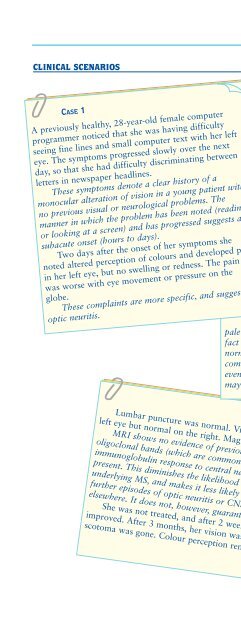Create successful ePaper yourself
Turn your PDF publications into a flip-book with our unique Google optimized e-Paper software.
Disorders of special senses113CLINICAL SCENARIOSCASE 1A previously healthy, 28-year-old female computerprogrammer noticed that she was having difficultyseeing fine lines and small computer text with her lefteye. The symptoms progressed slowly over the nextday, so that she had difficulty discriminating betweenletters in newspaper headlines.These symptoms denote a clear history of amonocular alteration of vision in a young patient withno previous visual or neurological problems. Themanner in which the problem has been noted (readingor looking at a screen) and has progressed suggests asubacute onset (hours to days).Two days after the onset of her symptoms shenoted altered perception of colours and developed painin her left eye, but no swelling or redness. The painwas worse with eye movement or pressure on theglobe.These complaints are more specific, and suggestoptic neuritis.On examination, her Snellen visual acuity was6/36 in the left eye and 6/5 in the right eye.Confrontation visual fields were normal on theright, but demonstrated a central scotoma on theleft. Colours were less intense in the left eye, andshe could only read 7/13 Ishihara plates in thateye. There was an afferent pupillary defect onthe left. Fundoscopy was normal bilaterally. Therest of her neurological examination wasnormal.Afferent pupillary defects occur with anyoptic nerve injury. Similarly, marked reductionin visual acuity, central scotoma, and alteredcolour vision merely denote optic nerve injury,rather than its cause, but the combination offeatures is characteristic of optic neuritis.Examination will usually be normal in opticneuritis, but in about one-fifth of casespapillitis (swelling of the optic nerve head)will be seen. Eventually the disc will appearpale (optic atrophy), especially the temporal aspect. Thefact that the rest of the neurological examination wasnormal is extremely important, because optic neuritis is acommon presentation of MS, and a previous neurologicalevent at a different site may have been subclinical (i.e.may not have caused symptoms).Lumbar puncture was normal. Visual evoked potentials were delayed in theleft eye but normal on the right. Magnetic resonance imaging (MRI) was normal.MRI shows no evidence of previous episodes of demyelination, andoligoclonal bands (which are commonly detected in MS and reflectimmunoglobulin response to central nervous system [CNS] antigens) are notpresent. This diminishes the likelihood that the optic neuritis was secondary tounderlying MS, and makes it less likely that the patient will go on and havefurther episodes of optic neuritis or CNS inflammation / demyelinationelsewhere. It does not, however, guarantee freedom from further episodes.She was not treated, and after 2 weeks her visual symptoms graduallyimproved. After 3 months, her vision was 6/6 in both eyes, and the centralscotoma was gone. Colour perception remained slightly reduced on the left.
















